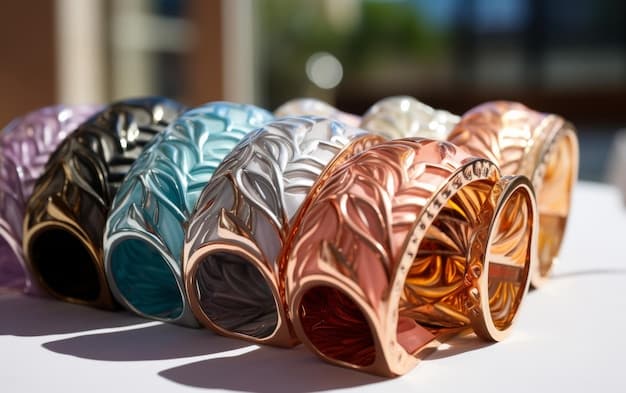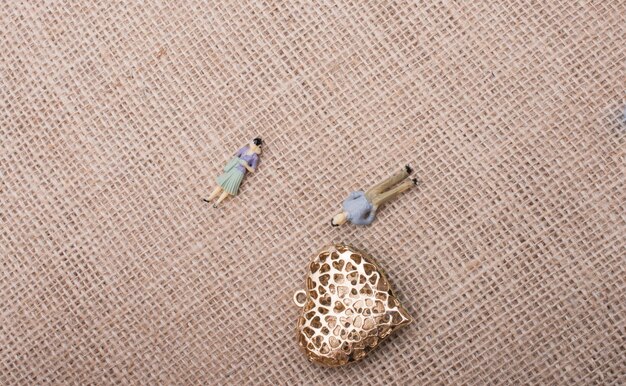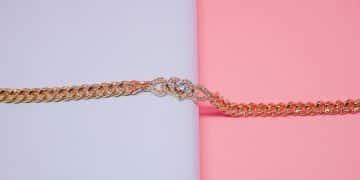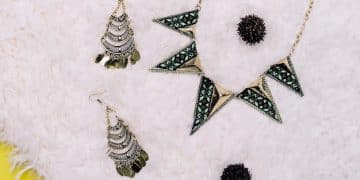Fashion Jewelry Metals Guide 2025: Durability, Cost & Appearance Insight

This comprehensive guide explores the essential characteristics of popular fashion jewelry metals in 2025, detailing their durability, typical cost ranges, and aesthetic appearance to help consumers make informed purchasing decisions that align with their style and budget.
Navigating the intricate world of fashion jewelry can be a delightful, yet sometimes daunting, experience. With countless designs and materials, understanding what goes into your chosen piece is crucial, especially when considering the Fashion Jewelry Metals Guide: Understanding Durability, Cost, and Appearance in 2025. This guide aims to demystify the core components, empowering you to select jewelry that not only captivates the eye but also stands the test of time and fits within your budget.
The Fundamentals of Fashion Jewelry Metals
Fashion jewelry, often referred to as costume or bridge jewelry, stands distinct from fine jewelry primarily due to the materials used. While fine jewelry typically employs solid precious metals like gold, platinum, and sterling silver with natural gemstones, fashion jewelry embraces a broader spectrum of metals, offering affordability, versatility, and trend-driven designs. These metals are often base metals, plated or coated with more precious materials, or alloys designed for specific properties.
The choice of metal significantly influences a piece’s longevity, aesthetic appeal, and price point. Understanding these foundational aspects is key to appreciating the value and potential wear of fashion jewelry. Consumers may look for pieces that mimic the look of fine jewelry without the hefty price tag, or they might seek out unique, artistic expressions that prioritize specific textures or finishes. The distinction often lies in the core composition and the layers applied to achieve the desired look and feel.
Common Base Metals in Fashion Jewelry
Several base metals form the backbone of fashion jewelry production. These are chosen for their malleability, widespread availability, and cost-effectiveness. However, their raw appearance is often not suitable for direct use in jewelry, necessitating further treatment.
- Brass: An alloy of copper and zinc, brass is known for its gold-like appearance. It’s easily workable and takes plating well, but can tarnish over time and may cause skin discoloration for some wearers.
- Copper: One of the oldest metals used in adornment, copper has a distinct reddish-brown hue. It’s often used in alloys or plated, as pure copper can also tarnish and leave marks on skin.
- Alloy Metals: Proprietary blends of various non-precious metals are common, designed to be lightweight, strong, and receptive to plating. Their exact composition varies by manufacturer.
The durability of these base metals, absent any coating, is generally moderate. They are susceptible to oxidation and skin reactions. Therefore, their application in fashion jewelry almost always involves subsequent plating processes to enhance both appearance and wearability. The choice of base metal often hinges on the desired final weight and the metal’s ability to bond with various plating layers, ensuring a stable and long-lasting finish.
Plating Techniques: Enhancing Appearance and Durability
Plating is a critical process in fashion jewelry, transforming inexpensive base metals into visually appealing pieces that mimic the look of more expensive fine jewelry. This technique involves depositing a thin layer of a more precious or protective metal onto the surface of a base metal. The thickness of this layer is paramount to the jewelry’s durability and price.
Various plating techniques are employed, each with its own advantages and limitations. Electroplating is the most common method, utilizing an electric current to reduce dissolved metal cations so that they form a coherent metal coating on the base material. The quality of the plating directly impacts how long the jewelry retains its luster and resists wear.
- Gold Plating: A thin layer of gold is applied over a base metal. The thickness is often measured in microns; thicker plating, such as vermeil (sterling silver base with a thick gold layer), offers superior durability.
- Silver Plating: Similar to gold plating, a silver layer is applied. This can be prone to tarnishing, but can also be treated with anti-tarnish coatings.
- Rhodium Plating: A member of the platinum family, rhodium is incredibly bright, reflective, and resistant to tarnish. It’s commonly used over white gold or sterling silver to achieve a bright, white finish and enhance durability.
A poorly plated piece might flake, chip, or show the underlying base metal quickly, diminishing its aesthetic value and perceived quality. Therefore, understanding the type and thickness of plating is a significant factor in assessing the longevity and overall value of a fashion jewelry piece. Thicker plating generally translates to a higher cost but also greater resilience.
In summary, the foundational selection of base metals combined with sophisticated plating techniques allows manufacturers to create a vast array of fashion jewelry styles that are both accessible and fashionable. This intricate process ensures that pieces can be designed to cater to diverse aesthetic tastes while maintaining a reasonable price point, making trendy designs available to a wider audience.
Understanding Durability: A Key Factor in Longevity
When selecting fashion jewelry, “durability” often translates to how well a piece withstands daily wear and tear without losing its appeal. This is not solely about the hardness of the metal but also its resistance to tarnish, corrosion, and abrasion. Factors like the metal’s composition, the plating quality, and even the wearer’s skin chemistry can influence its longevity. While fashion jewelry is generally not designed for heirloom status, good durability ensures your favorite pieces remain beautiful for a reasonable lifespan, offering excellent value for their cost.
The metals used in fashion jewelry vary widely in their inherent durability properties. Some metals react more readily with elements in the environment, such as oxygen and sulfur, leading to discoloration. Others are softer and more prone to scratching or bending under pressure. Understanding these characteristics helps in making informed choices that align with your lifestyle and how often you intend to wear a particular piece.
Factors Influencing Metal Durability
Several critical factors determine how durable a piece of fashion jewelry will be. It’s a complex interplay of material science and practical usage.
- Metal Composition: Some base metals are inherently more stable than others. For example, stainless steel is renowned for its rust and tarnish resistance, making it highly durable. Silver, while beautiful, is known to tarnish.
- Plating Thickness and Type: As discussed, thicker plating provides a more robust barrier against wear. Rhodium plating, for instance, offers superior hardness and tarnish resistance compared to standard gold plating.
- Exposure to Chemicals: Perfumes, lotions, cleaning products, and even natural skin oils can degrade metal finishes over time. Chlorine in pools is particularly damaging to many jewelry metals.
Ultimately, the longevity of your fashion jewelry is a combination of its inherent qualities and how well it is cared for. Even the most durable metals can succumb to improper handling or harsh environmental conditions. Therefore, understanding these factors empowers consumers to both choose wisely and maintain their purchases effectively, maximizing their investment in trending accessories.
Common Pitfalls and How to Avoid Them
Even with the most durable fashion jewelry, certain habits can drastically shorten its lifespan. Recognizing these common pitfalls and adopting protective measures is essential for maintaining the beauty and integrity of your pieces. Prevention is always better than cure, especially when it comes to preserving delicate finishes and intricate designs.
- Moisture Exposure: Water, especially chlorinated or salt water, can accelerate tarnishing and damage plating. Always remove jewelry before swimming or showering.
- Chemical Contact: Direct contact with household cleaners, perfumes, and hairsprays can erode plating and dull metals. Apply these products before putting on your jewelry.
- Impact and Abrasion: Hard knocks or rubbing against other abrasive surfaces can cause scratches and chips, revealing the base metal underneath. Store jewelry separately and handle with care.
By being mindful of these common issues, consumers can significantly extend the life of their fashion jewelry. Simple habits like storing pieces in a dry, airtight container, cleaning them with a soft cloth, and avoiding harsh chemicals can make a substantial difference. Prioritizing care not only preserves the aesthetic appeal but also ensures that the pieces continue to bring joy for seasons to come. This proactive approach distinguishes informed jewelry owners from those who may quickly find their pieces losing charm.
The quest for durable fashion jewelry is a balance between understanding material properties and adopting sensible care routines. While no fashion piece is entirely impervious to wear, informed choices and diligent maintenance can significantly prolong its life, ensuring your accessories remain vibrant and reflective of your personal style for an extended period. This pragmatic approach reinforces the idea that true value in fashion jewelry extends beyond initial aesthetics to encompass lasting quality.
Cost Considerations: Price vs. Value
The perceived value of fashion jewelry often begins with its price tag, but a deeper understanding reveals that true value encompasses far more than just monetary outlay. Unlike fine jewelry, where material weight and purity heavily dictate cost, fashion jewelry’s pricing is influenced by a diverse array of factors including design complexity, brand prestige, production volume, and the specific metals and finishes used. A piece might be inexpensive yet offer tremendous value due to its unique design and trend relevance, or it could command a higher price due to superior plating and craftsmanship, promising extended wear.
Understanding these underlying cost drivers is essential for making astute purchasing decisions. It helps consumers differentiate between genuinely well-made, durable pieces and those that might simply reflect passing trends or minimal investment in materials. This knowledge empowers buyers to align their expectations with their budget, ensuring that they feel they have received fair value for their purchase, regardless of the price point.

Factors Driving Fashion Jewelry Costs
The price of fashion jewelry is a multifaceted equation influenced by several key elements. Each component contributes to the final retail cost, and being aware of these can help consumers appreciate why certain pieces are priced as they are. It’s not always just about the metal itself, but the entire journey from raw material to a finished, beautiful accessory.
- Material Selection: The specific base metal (e.g., brass vs. stainless steel) and the type and thickness of plating (e.g., standard gold plating vs. heavy gold plating or vermeil) are primary cost drivers. More noble or thicker platings naturally increase the price.
- Design Complexity: Intricate designs, detailed filigree, or pieces requiring extensive hand assembly or specialized techniques will command higher prices due to increased labor and production time.
- Brand and Marketing: Established brands often have higher overheads for marketing, retail presence, and perceived exclusivity, which are reflected in their pricing. Artisan-made or limited-edition pieces might also be priced higher due to uniqueness.
Additionally, ethical sourcing of materials and sustainable production practices can influence costs, as these often involve more rigorous supply chain management and specialized processes. The global market dynamics, including raw material costs and labor wages in different regions, also play a subtle but significant role in setting price points. Thus, what appears to be a simple piece of jewelry is often the result of a complex economic process.
Cost-Effective Options for Every Budget
Fortunately, the fashion jewelry market is vast and diverse, offering beautiful and stylish options across every budget. From readily accessible pieces perfect for experimenting with trends to more investment-worthy items designed for longevity, there is something for everyone. Smart shopping involves knowing where to find quality within your price range.
- Stainless Steel: Highly durable, hypoallergenic, and affordable, stainless steel jewelry is an excellent choice for everyday wear. It offers a sleek, modern aesthetic and resists tarnishing exceptionally well.
- Gold-Filled vs. Gold-Plated: For a step up in durability and appearance from simple gold plating, consider gold-filled jewelry. This involves a much thicker layer of gold permanently bonded to a base metal, offering a look and feel closer to solid gold at a fraction of the price. While it costs more than standard plating, its longevity often justifies the difference.
- Rhodium-Plated Brass/Alloy: For a bright, silver-toned look that resists tarnish better than pure silver, rhodium-plated options offer good value. They mimic the appearance of white gold or platinum without the associated cost, making them ideal for trend-forward pieces.
Exploring options beyond the absolute cheapest items can often lead to greater satisfaction and a better return on investment over time. Sometimes, paying a little more upfront for a piece with superior materials or construction means it will last longer, reducing the need for frequent replacements. This thoughtful approach to budgeting helps consumers build a collection of cherished pieces that truly reflects their style and values.
In essence, the relationship between cost and value in fashion jewelry is dynamic. While a lower price point might allow for more frequent trend updates, investing slightly more in pieces with enhanced durability and thoughtful design can provide lasting enjoyment. By understanding the factors that drive cost and exploring the various material options available, consumers can skillfully navigate the market to find pieces that not only fit their budget but also exceed their expectations in both style and longevity.
The Aesthetic Appeal: Appearance and Finish
Beyond durability and cost, the aesthetic appeal of fashion jewelry is arguably its most captivating attribute. It’s the visual language through which pieces communicate style, personality, and current trends. The appearance of a piece is fundamentally shaped by the metal’s inherent color, its chosen finish, and any subsequent treatments like plating or etching. From the warm glow of gold to the cool sheen of silver and the modern edge of blackened metals, each aesthetic choice contributes to the overall narrative of the jewelry, making it a powerful statement accessory. The right choice can elevate an outfit, define a mood, or simply bring joy to the wearer.
The finish of a metal also plays a crucial role in its perceived quality and how it interacts with light. Whether polished to a high shine, brushed for a matte effect, or textured for a unique feel, the finish dramatically alters the jewelry’s character. Fashion trends constantly evolve, and with them, new finishes and color combinations emerge, offering endless possibilities for designers and consumers alike. Understanding these nuances helps in selecting pieces that not only look good but truly resonate with personal style.
Popular Metal Colors and Finishes in 2025
The year 2025 sees a continuation of classic preferences alongside a rise in bolder, more experimental aesthetics. The interplay of color and finish defines the current landscape of fashion jewelry, offering diverse options for every taste. These trends reflect a blend of timeless elegance and contemporary flair, allowing for versatile styling.
- Classic Gold Tones: Yellow gold remains a perennial favorite, evoking warmth and luxury. Alongside traditional gold plating, rose gold continues to gain traction for its romantic, subtle pink hue, often created by alloying gold with copper.
- Silver and White Metals: Bright silver tones, achieved through silver plating or rhodium plating over base metals, maintain their popularity for a clean, modern, and versatile look. Platinum-toned finishes also offer a sophisticated, understated elegance that pairs well with virtually any outfit.
- Mixed Metals: A significant trend in 2025 is the deliberate mixing of different metal colors within a single piece or when layering jewelry. This creates a dynamic, personalized, and effortlessly chic appeal that breaks from traditional matched sets.
Beyond color, finishes like brushed, hammered, or satin provide texture and diffuse light, adding depth and a bespoke feel to pieces. Blackened or oxidized finishes also offer a dramatic contrast, lending an edgy, antique, or industrial vibe, perfect for those seeking a departure from conventional sparkle. These diverse options ensure that fashion jewelry remains a rich field for personal expression.
Elevating Style Through Metal Choices
The choice of metal is not merely incidental; it’s a fundamental design decision that can significantly elevate a piece’s style and its overall impact. Different metals and finishes carry distinct connotations and can complement various skin tones, outfits, and occasions. Thoughtful metal selection allows designers to imbue their creations with specific moods—from minimalist chic to opulent grandeur.
For instance, pieces made from sleek, polished stainless steel often convey a minimalist and modern aesthetic, ideal for contemporary looks or professional settings. Highly detailed designs in antique-finished brass or copper can evoke a vintage, bohemian, or artisanal feel, perfect for adding character to more relaxed ensembles. The strategic use of gold-toned metals can instantly add a touch of glamour and sophistication, suitable for both daily wear and special events.
- Complementing Skin Tones: Warm-toned metals like yellow gold and rose gold tend to flatter warm skin tones, while cool-toned metals such as silver and white gold often complement cool skin tones.
- Versatility in Layering: The appearance of different metals can be creatively combined in layering. Mixing thin gold chains with chunkier silver pendants, for example, creates visual interest and reflects a modern, eclectic style.
- Impact and Statement: The size, texture, and finish of a metal piece contribute to its statement level. A large, hammered copper cuff makes a bold, artistic impression, whereas delicate, rhodium-plated earrings offer subtle elegance.
Ultimately, the aesthetic appeal of fashion jewelry metals lies in their transformative power. They are not merely materials but tools for artistic expression. By understanding how different metals, colors, and finishes interact, consumers can curate a collection that not only enhances their appearance but also truly reflects their unique style narrative, making every piece a carefully considered element of their personal brand. This approach turns a simple accessory into a powerful component of self-expression.
Care and Maintenance for Optimal Appearance
Even the most durable fashion jewelry requires mindful care to maintain its lustrous appearance and extend its wearable life. Unlike fine jewelry, which often tolerates more rigorous cleaning methods, fashion jewelry, with its common use of plating and sometimes more delicate constructions, demands a gentler approach. Proper care isn’t just about cleaning; it encompasses how you wear, store, and protect your pieces from everyday hazards. Neglecting these practices can quickly lead to tarnishing, chipping of plating, or dulling of finishes, diminishing the very aesthetic appeal that drew you to the piece in the first place.
Implementing a simple, consistent care routine can significantly delay the signs of wear and tear, ensuring your favorite accessories continue to sparkle and enhance your style for as long as possible. This proactive approach not only preserves the beauty of your jewelry but also protects your investment, however modest, in fashion-forward pieces. Understanding the specific needs of different metals and finishes is the first step toward effective maintenance.
Best Practices for Daily Wear and Storage
The way you incorporate fashion jewelry into your daily routine and how you store it when not in use are crucial determinants of its longevity. Small habits can make a big difference, protecting your pieces from unnecessary exposure and damage. Think of it as a set of golden rules for keeping your accessories pristine.
- “Last On, First Off” Rule: Put on your jewelry after applying perfumes, lotions, hairsprays, and makeup. These products contain chemicals that can tarnish or strip plating. Similarly, take off your jewelry before engaging in any activity that involves water (showering, swimming), sweating, or coming into contact with cleaning agents.
- Avoid Harsh Exposure: Keep jewelry away from direct sunlight, extreme heat, and humidity, as these can accelerate tarnishing and degradation. Avoid wearing jewelry while exercising, cleaning, or performing manual labor to prevent scratches, dents, or chemical exposure.
- Proper Storage: Store each piece of fashion jewelry separately in soft pouches or compartmentalized jewelry boxes to prevent scratching and entanglement. Airtight bags can help slow down the tarnishing process, especially for silver-plated items.
Regularly wiping your jewelry with a soft, dry cloth after each wear can also remove oils and residues that accumulate throughout the day, preventing buildup and preserving its shine. These simple daily practices form the bedrock of effective fashion jewelry care, ensuring your pieces stay beautiful longer.
Gentle Cleaning Techniques for Various Metals
While daily habits prevent damage, occasional cleaning is necessary to restore shine and remove accumulated grime. However, the cleaning method must be tailored to the specific metal and finish to avoid causing further damage. A gentle touch is always paramount, especially with plated items.
- For Gold-Plated and Silver-Plated Items: Use only a soft, lint-free cloth, slightly dampened with plain water if necessary. Absolutely avoid abrasive cleaners, jewelry polishing cloths (which can remove plating), and ultrasonic cleaners. Gently wipe the surface to remove dirt and oils, then dry thoroughly.
- For Stainless Steel: Stainless steel is quite robust. It can be cleaned with mild soap and water, then rinsed and dried thoroughly. For stubborn marks, a soft cloth with rubbing alcohol can be used, but always test on an inconspicuous area first.
- For Unplated Brass or Copper: These metals can be cleaned with specific metal polishing cloths designed for them, or with a mild solution of lemon juice and baking soda. Rinse well and dry completely to prevent water spots.
Always ensure jewelry is completely dry before storing it, as moisture is a primary catalyst for tarnishing and corrosion. If unsure about the best cleaning method for a particular piece, err on the side of caution with a soft, dry cloth. Proactive care and gentle specific cleaning techniques will extend the vibrancy and appeal of your fashion jewelry, allowing you to enjoy your chosen pieces for many seasons to come. This attention to detail reflects a deeper appreciation for your accessories.
Emerging Trends and Innovations in 2025 Metals
The world of fashion jewelry is constantly evolving, driven by innovation in materials science, shifts in consumer preferences, and a growing emphasis on sustainability. As we look towards 2025, several emerging trends and technological advancements are shaping the landscape of jewelry metals, moving beyond traditional base-metal plating to explore novel materials and more environmentally conscious practices. These innovations promise not only fresh aesthetic possibilities but also enhanced durability, hypoallergenic properties, and a reduced environmental footprint, aligning with a more informed and ethical consumer base.
Designers are increasingly experimenting with alternative materials and advanced finishes, pushing the boundaries of what is possible in mass-produced and artisanal fashion jewelry. This evolution speaks to a desire for unique, distinctive pieces that also meet contemporary values of longevity and responsible sourcing. The focus is shifting towards smarter, more sustainable luxury that remains accessible to the broader market of fashion enthusiasts.
Sustainable and Eco-Friendly Metal Choices
Sustainability is no longer a niche concern but a driving force across industries, and fashion jewelry is no exception. Consumers are more aware of the environmental and social impacts of manufacturing, leading to a demand for metals and processes that align with eco-conscious values. This push is fostering innovation in both sourcing and material development.
- Recycled Metals: A growing trend is the use of recycled brass, copper, and even sterling silver in fashion jewelry. This significantly reduces the environmental impact associated with mining new materials and supports a circular economy model.
- Ethical Sourcing: Beyond recycling, there’s an increased focus on responsibly sourced new metals, ensuring that mining practices are ethical and minimize ecological damage. Brands are providing greater transparency about their supply chains.
- Bio-based Materials: While still nascent, research into bio-based or composite materials that mimic metal properties is gaining traction, offering potential future alternatives for fashion jewelry components, reducing reliance on traditional metal resources entirely.
The emphasis on durability also plays a role in sustainability; pieces that last longer reduce the need for constant replacement, thus lowering overall consumption and waste. This holistic approach to sustainability is influencing material choices, driving innovation toward more environmentally benign options and processes that resonate with the values of the modern consumer.
Advanced Materials and Hypoallergenic Options
Technological advancements are leading to the introduction of more sophisticated materials and improved properties in fashion jewelry, particularly concerning hypoallergenic qualities and enhanced performance. For consumers with sensitive skin, these innovations are particularly impactful, opening up a wider range of styling options without discomfort.
- Titanium and Niobium: Increasingly seen in high-end fashion and bridge jewelry, these metals are exceptionally lightweight, strong, and highly hypoallergenic. Their distinctive colors and ability to be anodized into a spectrum of vibrant hues make them attractive for contemporary designs.
- Surgical Stainless Steel: While traditional stainless steel is common, surgical-grade variants offer even higher purity and corrosion resistance, making them virtually inert and excellent for individuals with metal sensitivities.
- Ceramic and Tungsten Carbide: Though not metals in the traditional sense, these incredibly hard and scratch-resistant materials are gaining popularity for their modern aesthetic, durability, and hypoallergenic properties in rings and bangles, offering a sleek, polished look that resists wear.
Innovations in plating techniques are also yielding more durable and less reactive coatings, expanding the range of safe and stylish options for all wearers. These developments reflect a global trend towards personal well-being and a desire for products that offer both beauty and practical benefits. The future of fashion jewelry metals is clearly moving towards a blend of aesthetics, advanced functionality, and ethical considerations, promising an exciting array of new choices for discerning consumers in 2025 and beyond.
Making Informed Choices: A Consumer’s Guide
Navigating the diverse landscape of fashion jewelry metals in 2025 can be both exciting and challenging. With countless options in terms of durability, cost, and appearance, making an informed choice requires a clear understanding of your priorities and the characteristics of the materials available. It’s not just about what looks good, but what truly meets your needs for longevity, budget, and comfort. This section aims to equip you with the knowledge to make smart decisions, ensuring that every piece of fashion jewelry you acquire is a valued addition to your collection.
Ultimately, the “best” metal isn’t universal; it’s deeply personal. What suits one individual’s lifestyle, skin type, or aesthetic preference might not be suitable for another. Therefore, self-reflection on your wearing habits and desired outcomes is just as important as understanding the technical specifications of the metals themselves. By combining personal insight with material knowledge, you can confidently select pieces that bring joy and serve their purpose effectively.
Matching Metal to Lifestyle and Budget
The synergy between your chosen metal and your daily life is paramount for satisfaction. A high-maintenance metal may be beautiful but impractical for someone living an active lifestyle, just as an expensive piece might be ill-suited for occasional wear if budget is a main concern. Consider how often you’ll wear the piece, what activities you’ll be doing, and how much you’re willing to spend.
- Everyday Wear: For pieces you intend to wear daily, opt for highly durable and tarnish-resistant metals like stainless steel, surgical steel, or high-quality gold-filled items. These withstand prolonged exposure and activity better.
- Occasional or Statement Pieces: For jewelry worn less frequently or primarily for special occasions, a wider range of plated metals can be considered without excessive worry about wear. This allows for greater experimentation with trends without a huge investment.
- Budget-Conscious Choices: If affordability is key, explore quality rhodium-plated alloys or well-made standard gold-plated brass. While not as long-lasting as higher-tier options, they offer excellent value for transient fashion trends.
Remember that investing a little more initially for a more durable metal or thicker plating can often save money in the long run by reducing the need for replacements. Similarly, if you have sensitive skin, prioritizing hypoallergenic metals, even if they come at a slightly higher cost, will prevent discomfort and allergic reactions, enhancing your overall wearing experience and ensuring that your jewelry is a pleasure, not a problem.
Identifying Quality: What to Look For
While fashion jewelry doesn’t typically come with detailed certifications like fine jewelry, there are still key indicators of quality that informed consumers can look for to ensure they are getting good value. These visual cues and product descriptions can help discern well-made pieces from those of lesser quality, preventing disappointment.
- Evenness of Plating: Examine the surface for any signs of unevenness, bubbling, or peeling in the plating. High-quality plating should appear smooth and consistent across the entire piece.
- Weight and Feel: While subjective, a piece that feels surprisingly light for its size might indicate a very thin base metal or hollow construction. Quality fashion jewelry often has a substantial, well-balanced feel.
- Clasp and Fastenings: Check the functionality and construction of clasps, earring backs, and chain links. They should be sturdy, operate smoothly, and securely fasten. Flimsy closures are a sign of cost-cutting.
- Seller’s Reputation and Transparency: Purchase from reputable retailers or brands that provide clear information about the materials used, plating thickness (if applicable), and care instructions. Transparency often correlates with a commitment to quality.
Don’t hesitate to ask questions about the materials and recommended care. A knowledgeable seller should be able to provide details that help you make an informed decision. By paying attention to these details, you can significantly improve your chances of acquiring fashion jewelry that not only looks beautiful but also holds up well to wear, enhancing your overall satisfaction and enjoyment of your chosen pieces. This discerning approach elevates your shopping experience.
| Key Point | Brief Description |
|---|---|
| ✨ Durability | Impacted by base metal, plating thickness, and care. Stainless steel offers high resistance to tarnish and wear. |
| 💰 Cost | Varies by material rarity, design complexity, brand, and plating quality. Gold-filled is pricier but more durable than gold-plated. |
| 🎨 Appearance | Influenced by metal color (gold, silver, rose), finish (polished, brushed), and plating effects. Mixed metals trending. |
| 🌿 Trends 2025 | Focus on sustainable recycled metals and hypoallergenic options like titanium and surgical steel for lasting appeal. |
Frequently Asked Questions
▼
For everyday fashion jewelry, stainless steel is often considered the most durable and practical metal. It is highly resistant to rust, corrosion, tarnishing, and scratching. Surgical-grade stainless steel is also hypoallergenic, making it ideal for continuous wear, even for individuals with sensitive skin.
▼
Gold-plated jewelry has a very thin layer of gold applied over a base metal, making it more affordable but less durable and prone to wear. Gold-filled jewelry involves a much thicker layer of gold mechanically bonded to a base, offering significantly greater durability and a closer appearance to solid gold, thus commanding a higher price point.
▼
Yes, certainly. For those with sensitivities, excellent hypoallergenic options include surgical stainless steel, titanium, and niobium. These metals are celebrated for their inertness and are less likely to cause allergic reactions compared to common base metals like nickel, which is often found in cheaper alloys.
▼
To preserve fashion jewelry’s appearance, follow the “last on, first off” rule for beauty products, remove it before showering or swimming, and avoid harsh chemicals. Store pieces individually in soft pouches or airtight bags to prevent scratching and reduce exposure to air, which can cause tarnishing.
▼
Plating thickness is a critical factor in longevity. A thicker layer of plating provides a more robust barrier against wear, abrasion, and chemical exposure, significantly extending the life and maintaining the aesthetic of the piece. Thicker plating typically means higher quality and cost, but also better durability over time.
Conclusion
The journey through the world of fashion jewelry metals reveals a fascinating interplay of durability, cost, and aesthetic appeal. In 2025, consumers are more empowered than ever to make informed decisions, thanks to a broader understanding of material properties, innovative production techniques, and a rising consciousness around sustainability. Whether you seek the enduring resilience of stainless steel, the accessible luxury of gold-filled pieces, or the hypoallergenic comfort of titanium, each metal offers a unique set of characteristics that can perfectly align with your individual style, lifestyle, and budget. By prioritizing careful selection and diligent care, your fashion jewelry pieces can not only serve as expressions of your personal taste but also stand as lasting, cherished additions to your collection. The beauty of fashion jewelry truly lies in its ability to offer diverse and exciting options for every discerning eye.





